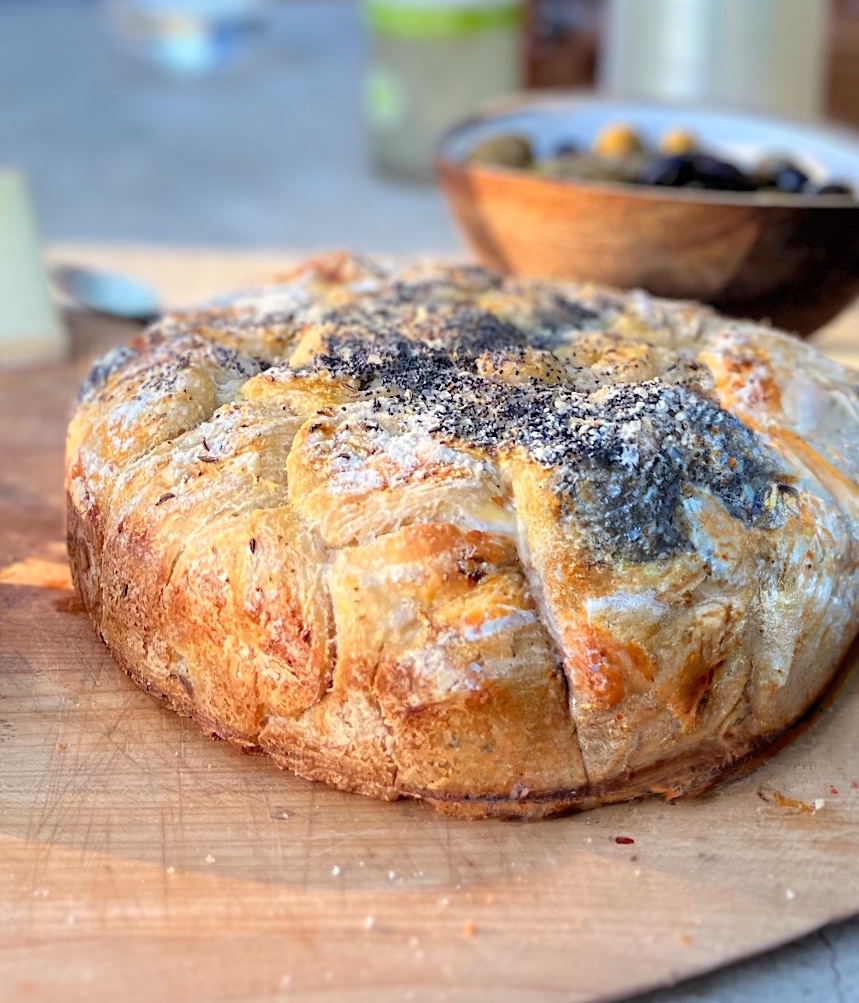Yemenite Jews began baking Kubaneh breads around 70 AD, after the destruction of the second Temple. Chad Robertson’s first sourdough loaves emerged from Tartine’s ovens ( The Modern day temple to bread) in 2002. My version is a hybrid of the two, fusing pillow soft rolls with a long slow ferment and rise.
Kubaneh is a traditional bread that has its roots in the Yemenite Jewish community. It is a slow-cooked, pull-apart bread with a unique taste and texture. The bread is typically prepared on Friday evenings and served as part of the Sabbath (Shabbat) meal.
Kubaneh can be served plain, but it is often accompanied by various dips and spreads, such as grated tomatoes, zhug (a spicy Yemenite condiment), and hard-boiled eggs. It can also be served with dishes like jachnun, a slow-cooked Yemenite pastry, and various stews and soups. The bread is FAMOUS for its ability to absorb flavors well, making it a popular choice for soaking up the sauces and juices from the accompanying dishes.
In recent years, Kubaneh has gained popularity outside of the Yemenite Jewish community, and can now be found in bakeries and restaurants specializing in Middle Eastern cuisine.

Here’s how to make the perfect sourdough Kubaneh at home
First step: pre-ferment the dough. The night before mix 25g sourdough starter with 100g warm water, 50g all purpose flour, and 50g whole wheat flour. Mix and seal in small container overnight. The goal is a bubbly brew of yeast, water and air.
Second step: Make the dough. In a medium bowl add the pre-ferment mixture from above. Pour in 350g of warm water. Add 400g of bread flour. Add 2 tbs sugar, one egg and one egg white. Reserve yolk for egg wash. Mix thoroughly until a shaggy, then smoother ball emerges. The desired outcome is a very wet dough that has a super elastic form. Pour mixture into a medium sized plastic container with lid.
Third step: Employ Tartine’s “mix and fold”method to aerate the dough. Every half hour dip your wet hands into the bottom of the container and scoop and fold the dough three times. Do this four times for a total of two hours. The idea is to grow the dough slowly but steadily by gently folding it onto itself in the container.
Fourth step: Let the dough rise without folding for another two hours. This is considered the bulk fermentation. Afterwards pour the dough mass onto a work surface and use a bench scraper and or floured hands to gently shape into a ball. Cut the big ball into sixteen smaller balls and flour to prevent sticking. Here we want lots of fluffy baby dough balls that will grow and puff up when baked.
Fifth step: Gently flatten the baby dough balls and roll them up two or three times to resemble a mini croissant. Arrange the tiny rolls in a greased spring form pan ( one or two layers- depending on size). Brush rolls with egg yolk wash and sprinkle with seeds of choice. I prefer a mix of poppy seed, caraway and fennel seeds. Let the “rolls” rest and grow slowly over time in a warm spot-out of direct heat or sunlight. We are aiming for an incremental steady rise over 4 to 6 hours.
Sixth step: Heat oven to 350 degrees. Bake pan for 40 minutes or until brown and crusty on top. Remove pan and let cool on rack with spring form latch released. Like a good sourdough loaf, the rolls should start to bend and crack with lots of fissures between them. The end product will have the airiness of Challah bread with the chew of a mature sourdough. Enjoy!


Kubaneh – Yemenite Jewish Loaf
Description
A hybrid of the traditional Yemenite bread and Tartine’s version, fusing pillow soft rolls with a long slow ferment and rise.
Ingredients
Pre Fermentation:
25 g sourdough starter
100g warm water
50g all purpose flour
50g whole wheat flour
Dough
350g warm water
400g bread flour
2 tbsp sugar
1 egg
1 egg white (save yolk)
Seed mix (for instance poppy, caraway and fennel)
Instructions
- Pre-ferment the dough. The night before mix 25g sourdough starter with 100g warm water, 50g all purpose flour, and 50g whole wheat flour. Mix and seal in small container overnight. The goal is a bubbly brew of yeast, water and air.
- Make the dough. In a medium bowl add the pre-ferment mixture from above. Pour in 350g of warm water. Add 400g of bread flour. Add 2 tbs sugar, one egg and one egg white. Reserve yolk for egg wash. Mix thoroughly until a shaggy, then smoother ball emerges. The desired outcome is a very wet dough that has a super elastic form. Pour mixture into a medium sized plastic container with lid.
- Employ Tartine’s “mix and fold”method to aerate the dough. Every half hour dip your wet hands into the bottom of the container and scoop and fold the dough three times. Do this four times for a total of two hours. The idea is to grow the dough slowly but steadily by gently folding it onto itself in the container.
- Let the dough rise without folding for another two hours. This is considered the bulk fermentation. Afterwards pour the dough mass onto a work surface and use a bench scraper and or floured hands to gently shape into a ball. Cut the big ball into sixteen smaller balls and flour to prevent sticking. Here we want lots of fluffy baby dough balls that will grow and puff up when baked.
- Gently flatten the baby dough balls and roll them up two or three times to resemble a mini croissant. Arrange the tiny rolls in a greased spring form pan ( one or two layers- depending on size). Brush rolls with egg yolk wash and sprinkle with seeds of choice. I prefer a mix of poppy seed, caraway and fennel seeds. Let the “rolls” rest and grow slowly over time in a warm spot-out of direct heat or sunlight. We are aiming for an incremental steady rise over 4 to 6 hours.
- Heat oven to 350 degrees. Bake pan for 40 minutes or until brown and crusty on top. Remove pan and let cool on rack with spring form latch released. Like a good sourdough loaf, the rolls should start to bend and crack with lots of fissures between them. The end product will have the airiness of Challah bread with the chew of a mature sourdough. Enjoy!





















